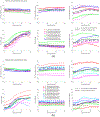In vivo tibiofemoral skeletal kinematics and cartilage contact arthrokinematics during decline walking after isolated meniscectomy
- PMID: 29122451
- PMCID: PMC6537593
- DOI: 10.1016/j.medengphy.2017.10.014
In vivo tibiofemoral skeletal kinematics and cartilage contact arthrokinematics during decline walking after isolated meniscectomy
Abstract
We investigated the effects of isolated meniscectomy on tibiofemoral skeletal kinematics and cartilage contact arthrokinematics in vivo. We recruited nine patients who had undergone isolated medial or lateral meniscectomy, and used a dynamic stereo-radiography (DSX) system to image the patients' knee motion during decline walking. A volumetric model-based tracking process determined 3D tibiofemoral kinematics from the recorded DSX images. Cartilage contact arthrokinematics was derived from the intersection between tibial and femoral cartilage models co-registered to the bones. The kinematics and arthrokinematics were analyzed for early stance and loading response phase (30% of a gait cycle), comparing the affected and intact knees. Results showed that four patients with medial meniscectomy had significantly greater contact centroid excursions in the meniscectomized medial compartments while five patients with lateral meniscectomy had significantly greater cartilage contact area and lateral shift of contact centroid path in the meniscectomized lateral compartments, comparing to those of the same compartments in the contralateral intact knees. No consistent difference however was identified in the skeletal kinematics. The current study demonstrated that cartilage-based intra-articular arthrokinematics is more sensitive and insightful than the skeletal kinematics in assessing the meniscectomy effects.
Keywords: Cartilage contact; Dynamic stereo-radiography; In vivo; Meniscectomy; Tibiofemoral kinematics.
Copyright © 2017 IPEM. All rights reserved.
Conflict of interest statement
Figures






References
-
- Montgomery SR, Zhang A, Ngo SS, Wang JC, Hame SL. Cross-sectional Analysis of Trends in Meniscectomy and Meniscus Repair. Orthopedics. 2013;36:e1007–13. - PubMed
-
- Englund M, Roos EM, Lohmander LS. Impact of type of meniscal tear on radiographic and symptomatic knee osteoarthritis: a sixteen-year followup of meniscectomy with matched controls. Arthritis Rheum. 2003;48:2178–87. - PubMed
-
- Scheller G, Sobau C, Bulow JU. Arthroscopic partial lateral meniscectomy in an otherwise normal knee: Clinical, functional, and radiographic results of a long-term follow-up study. Arthroscopy. 2001;17:946–52. - PubMed
-
- Andriacchi TP, Mundermann A, Smith RL, Alexander EJ, Dyrby CO, Koo S. A framework for the in vivo pathomechanics of osteoarthritis at the knee. Ann Biomed Eng. 2004;32:447–57. - PubMed
-
- Spang JT, Dang AB, Mazzocca A, Rincon L, Obopilwe E, Beynnon B, et al. The effect of medial meniscectomy and meniscal allograft transplantation on knee and anterior cruciate ligament biomechanics. Arthroscopy. 2010;26:192–201. - PubMed
Publication types
MeSH terms
Grants and funding
LinkOut - more resources
Full Text Sources
Other Literature Sources

